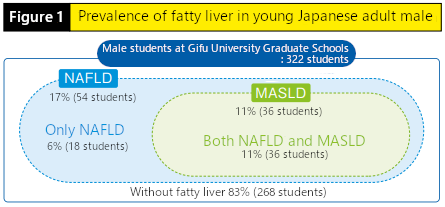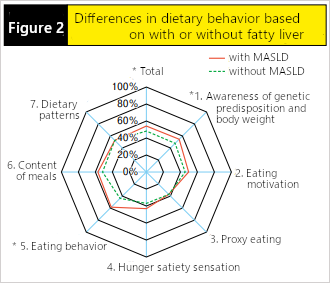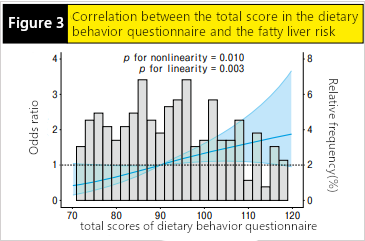Revealing the Relationship Between Non-Alcoholic Fatty Liver Disease (NAFLD) and 'Dietary Behavior' in Young Adult Men: Aiming for Early Prevention Before Early Treatment.
*Information related to faculty members/students and graduate schools at Gifu University here are all that of the time of interviewing.

Often underestimated, fatty liver can cause liver cancer and non-communicable diseases.

Approximately 30% of adult Japanese men have fatty liver, where fat accumulates within liver cells. While excess fat in the body is often thought to simply be stored in the liver, fat deposited in the liver can harm normal cells, leading to chronic hepatitis, liver cirrhosis, and eventually liver cancer. Fatty liver is closely associated with increased visceral fat, which endocrine various cytokines1) into the bloodstream. This can contribute to develop conditions like hypertension, diabetes, dyslipidemia, and atherosclerosis. Therefore, fatty liver is recognized as a risk factor for conditions such as stroke, heart attack, and atherosclerosis, and many fatalities in patients with fatty liver are related to cardiovascular diseases.
However, specific health checkups (commonly known in Japan as 'Metabo checks') designed to detect visceral fat accumulation early and prevent worsening of blood pressure, blood sugar, and lipid levels do not currently include fatty liver as part of the assessment. Additionally, these health checkups typically target individuals aged 40 and older, excluding younger generations. To address this gap, we have initiated a research project focusing on young adults with fatty liver. Gifu University, committed to lifelong health, aims to intervene early with students to reduce lifetime medical expenses, improve general health, and extend lifespan. We believe that it is more effective to intervene during youth, when individuals are more receptive to medical professional's advice and better able to adapt flexibly.
The main causes of chronic hepatitis include fatty liver, viruses (such as hepatitis B and C), and alcohol. Currently, vaccination provides prevention against viral hepatitis B, and medications allow for the treatment of hepatitis C. However, preventing fatty liver, which often lacks noticeable symptoms until it becomes severe, remains a significant challenge for medical researchers involved in hepatology.
People with metabolic abnormalities associated with fatty liver often exhibit deviation of dietary behavior.

17% and 11% for NAFLD and MAFLD, respectively.
In this study, conducted in April 2022, researchers investigated the relationship between the actual prevalence of fatty liver and dietary behavior among 322 male graduate students (median age, 22 years old) at our university. The prevalence of fatty liver was assessed by abdominal ultrasound in addition to routine blood tests during new students' health checkup. To ascertain dietary patterns, we utilized the 'Dietary Behavior Questionnaire' recommended by the Japan Society for the Study of Obesity. By answering a total of 55 questions across seven categories, participants' deviations and mistaken beliefs of dietary habits were visualized using diagrams based on cumulative scores.

or NAFLD tend to show higher scores in 'Awareness of constitution
and body weight' (category 1) and 'Eating behavior (category 5).'
According to the survey results, among individuals with fatty liver, metabolic dysfunction-associated steatotic liver disease (MASLD2)), was detected in 11% of the participants [Figure 1]. Additionally, it was found that responses related to the 'perception of physique and weight' within the seven categories of the questionnaire contribute to an increased risk of MASLD [Figure 2]. Students who held mistaken beliefs such as 'I am more prone to gaining weight than others' or 'I gain weight because I like sweet foods' tended to exhibit a higher prevalence of MASLD. Furthermore, it was evident that a higher total score--indicating significant deviations in dietary behavior--correlated with an elevated risk of fatty liver [Figure 3].
Fatty liver is associated with obesity4) in addition to genetic factors. While dietary and exercise therapy forms the basis of treatment, adding behavioral interventions can enhance its effectiveness. Students detected with fatty liver during health checkups gained insights through the results of dietary behavior questionnaires and were motivated for behavioral change. This research highlights the significant value of self-understanding for prevention and treatment. Currently, the researchers investigates the impact of varying intervention frequencies on preventive outcomes among undergraduate students.

towards the right, is associated with an increased risk (odds ratio) of fatty
liver.
From a series of research projects5), it has been found that even among university students, if serum alanine aminotransferase (ALT) level exceeds 29, there is a higher possibility of fatty liver. This finding supports the call by the Japan Society of Hepatology in the "Nara Declaration 2023" for individuals to consult their primary care physicians if their health checkup result shows an ALT level in excess of 30. Our research demonstraled this applies to young men as well.
The Gifu University Health Administration Center has a mission to equip Gifu University students, who will become future leaders in society, with the ability to select accurate knowledge and information for self-health management. We would be delighted if students feel free to use the Health Administration Center.
- *1 Cytokines are low-molecular-weight proteins primarily secreted by immune cells. They play a crucial role in intercellular signal transduction.
- *2 MASLD stands for Metabolic Dysfunction-Associated Steatotic Liver Disease. It is diagnosed when fatty liver coexists with any of the following conditions: obesity, type 2 diabetes, hypertension, or dyslipidemia.
- *3 NAFLD stands for Non-Alcoholic Fatty Liver Disease. In consideration of avoiding discriminatory terms included in the English name, a new definition, MASLD, has been introduced in 2023.
- *4 Obesity (BMI 25 and over) refers to a state where excess fat accumulates in the body. It is associated with conditions such as type 2 diabetes and hypertension.
- *5 Miwa T. et al. Sci Rep. 2024. 25;14(1):2194. doi: 10.1038/s41598-024-52797-8. Miwa T. et al. Hep Res. 2023. 53(8):691-700.doi: 10.1111/hepr.13906. Tajirika S. et al. Sci Rep. 2023. 18;13(1):7987. doi: 10.1038/s41598-023-34942-x.





